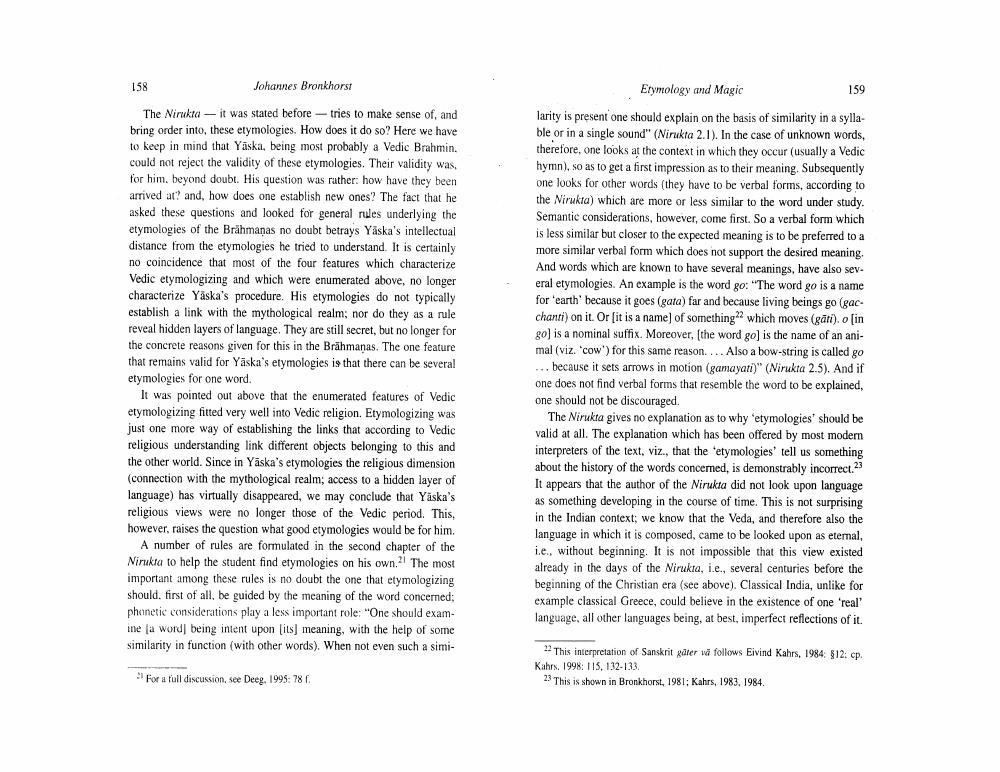Book Title: Etymology And Magic Yaskas Nirukta Flatos Cratylus And Riddle Of Semanticetymologies Author(s): Johannes Bronkhorst Publisher: Johannes Bronkhorst View full book textPage 7
________________ 158 Johannes Bronkhorst Erymology and Magic 159 The Nirukia - it was stated before - tries to make sense of, and bring order into these etymologies. How does it do so? Here we have to keep in mind that Yaska, being most probably a Vedic Brahmin. could not reject the validity of these etymologies. Their validity was, for him, beyond doubt. His question was rather: how have they been arrived at and, how does one establish new ones? The fact that he asked these questions and looked for general rules underlying the etymologies of the Brahmanas no doubt betrays Yaska's intellectual distance from the etymologies he tried to understand. It is certainly no coincidence that most of the four features which characterize Vedic etymologizing and which were enumerated above, no longer characterize Yaska's procedure. His etymologies do not typically establish a link with the mythological realm, nor do they as a rule reveal hidden layers of language. They are still secret, but no longer for the concrete reasons given for this in the Brahmanas. The one feature that remains valid for Yaska's etymologies is that there can be several etymologies for one word. It was pointed out above that the enumerated features of Vedic etymologizing fitted very well into Vedic religion. Etymologizing was just one more way of establishing the links that according to Vedic religious understanding link different objects belonging to this and the other world. Since in Yaska's etymologies the religious dimension (connection with the mythological realm, access to a hidden layer of language) has virtually disappeared, we may conclude that Yaska's religious views were no longer those of the Vedic period. This, however, raises the question what good etymologies would be for him. A number of rules are formulated in the second chapter of the Nirukta to help the student find etymologies on his own. The most important among these rules is no doubt the one that etymologizing should first of all, be guided by the meaning of the word concerned; phonetic considerations play a less important role: "One should examne la word being intent upon [ils] meaning, with the help of some similarity in function (with other words). When not even such a simi larity is present one should explain on the basis of similarity in a syllable or in a single sound" (Niruka 2.1). In the case of unknown words, therefore, one looks at the context in which they occur (usually a Vedic hymn), so as to get a first impression as to their meaning. Subsequently one looks for other words (they have to be verbal forms, according to the Nirukta) which are more or less similar to the word under study. Semantic considerations, however, come first. So a verbal form which is less similar but closer to the expected meaning is to be preferred to a more similar verbal form which does not support the desired meaning, And words which are known to have several meanings, have also several etymologies. An example is the word go: "The word go is a name for earth' because it goes (gata) far and because living beings go (gac. chanti) on it. Or it is a name of something which moves (gāti). o (in go) is a nominal suffix. Moreover, the word go] is the name of an animal (viz. cow) for this same reason. ... Also a bow-string is called go ... because it sets arrows in motion (gamayati)" (Nirukta 2.5). And if one does not find verbal forms that resemble the word to be explained, one should not be discouraged. The Nirukta gives no explanation as to why etymologies' should be valid at all. The explanation which has been offered by most modern interpreters of the text, viz., that the etymologies' tell us something about the history of the words concerned, is demonstrably incorrect. It appears that the author of the Nirukta did not look upon language as something developing in the course of time. This is not surprising in the Indian context; we know that the Veda, and therefore also the language in which it is composed, came to be looked upon as eemal, i.e, without beginning. It is not impossible that this view existed already in the days of the Nirukta, i.e., several centuries before the beginning of the Christian era (see above). Classical India, unlike for example classical Greece, could believe in the existence of one 'real' language, all other languages being, at best, imperfect reflections of it. 12 This interpretation of Sanskrit gater w follows Eivind Kahrs, 1984: $12: cp. Kahrx. 1998: 115, 132-133. 2. This is shown in Bronkhorst, 1981: Kahrs, 1983, 1984. For a full discussion, see Deeg. 1995:78f.Page Navigation
1 ... 5 6 7 8 9 10 11 12 13 14 15 16 17 18 19 20 21 22 23 24 25 26 27 28 29
